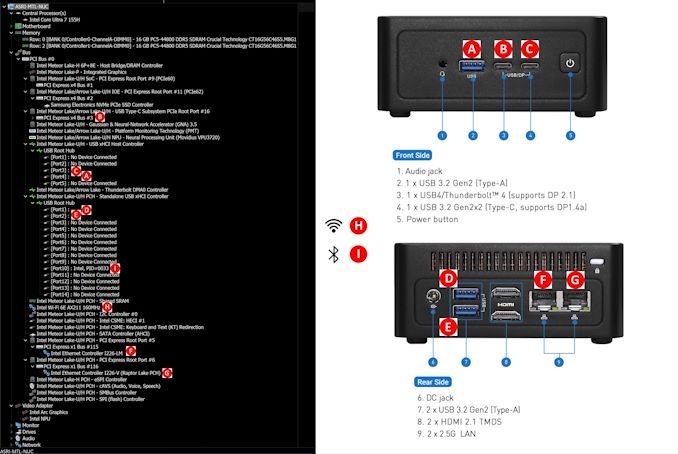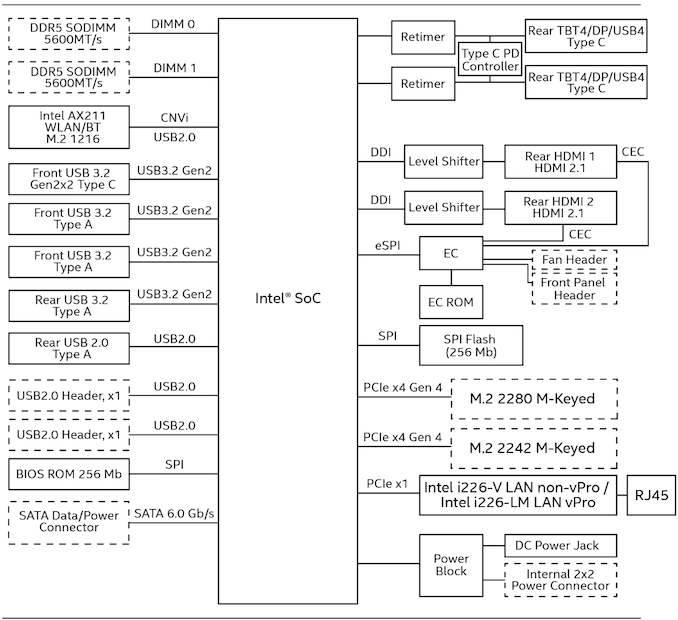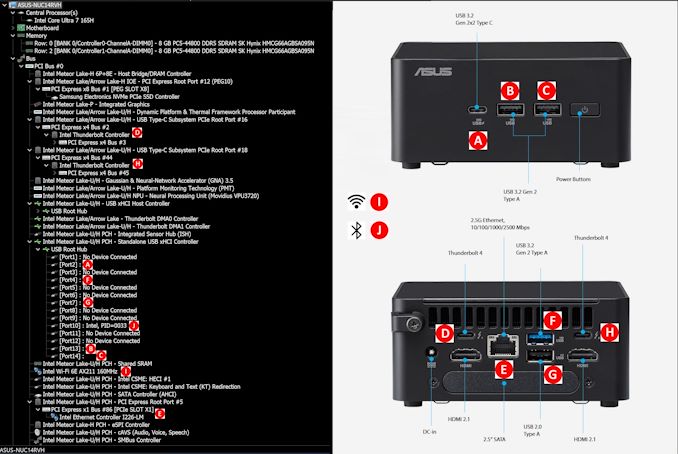ASUS NUC14RVHv7 and ASRock Industrial NUC BOX-155H Review: Meteor Lake Brings Accelerated AI to UCFF PCs
by Ganesh T S on May 23, 2024 8:00 AM EST- Posted in
- Systems
- Intel
- Asus
- NUC
- UCFF
- Mini-PC
- ASRock Industrial
- Meteor Lake
Setup Notes and Platform Analysis
Prior to setting up the OS on the ASRock Industrial NUC BOX-155H, we took some time to look into the BIOS interface. As is typical for systems targeting the industrial market, the main BIOS interface isa vanilla one, but does provide plenty of knobs for the end user to tweak. The video below presents the entire gamut of configuration options.
On the other hand, the BIOS of the ASUS NUC14RVHv7 is much more consumer-friendly with mouse support, and a decently fancy GUI. There are a lot more tweaks available in this BIOS, including the ability to set up different display emulation schemes for headless operation, and the Absolute Persistence Module in the Add-in Config to allow extensive remote management using software from Absolute (BIOS needs to support this software, and it is possible for the end user to allow its activation, or even permanently remove support for it).
The videos above do not go into the ME / AMT login screens, even though it is available in the BIOS. It should be noted that the vPro Enterprise capabilities of the ASUS NUC14RVHv7 allow for better manageability compared to the vPro Essentials in the Core Ultra 7 155H of the ASRock Industrial NUC BOX-155H.
The BIOS in the NUC systems have always had plenty of interesting features (including fine-grained fan control). The ASUS NUC14RVHv7 carries over these features. In addition, ASUS is also pushing the MyASUS application to provide such control at the OS level (for fan speeds as well as diagnostics and other device settings). This is for the average consumer who doesn't want to fiddle with BIOS settings, but power users may also find some interesting features in the application. For some use-cases / users, these are value-additions that may sway the purchase decision towards the ASUS models. This feature has been available in the ExpertCenter line-up for a few generations now. ASUS is also enabling support for this application in the NUC 14 Pro SKUs.
The block diagram below presents the overall high-speed I/O distribution from the NUC BOX-155H's user manual.

ASRock Industrial NUC BOX-155H Block Diagram
ASRock Industrial uses the Hayden Bridge retimer for the Thunderbolt port, allowing for USB 3.2 Gen 2x2 support on it. In terms of external I/O, the following bus layout diagram provides further insights.

ASRock Industrial NUC BOX-155H Bus Layout
The block diagram below presents the overall high-speed I/O distribution from the NUC 14 Pro technical product manual.
Even though it is not specifically mentioned, the retimers used for both USB4 ports are Hayden Bridge, allowing for USB 3.2 Gen 2x2 support on it. In terms of external I/O, the following bus layout diagram provides further insights.
In today's review, we compare the ASRock Industrial NUC BOX-155H and the ASUS NUC14RVHv7 with a host of other systems in a similar form-factor. TDPs for the processors range from 15W right up to 65W.
| Comparative PC Configurations | ||
| Aspect | ASUS NUC14RVHv7 (Revel Canyon vPro) | |
| CPU | Intel Core Ultra 7 165H Meteor Lake-H 6P + 8E + 2LPE / 22T, up to 5.0 GHz (P) up to 3.8 GHz (E) up to 2.5 GHz (LPE) Intel 4 (CPU) / TSMC N5 (iGPU), 24MB L2, Min / Max / Base TDP: 20W / 115W / 28W PL1 = 64W, PL2 = 64W |
Intel Core Ultra 7 165H Meteor Lake-H 6P + 8E + 2LPE / 22T, up to 5.0 GHz (P) up to 3.8 GHz (E) up to 2.5 GHz (LPE) Intel 4 (CPU) / TSMC N5 (iGPU), 24MB L2, Min / Max / Base TDP: 20W / 115W / 28W PL1 = 64W, PL2 = 64W |
| GPU | Intel Arc Graphics (8 Xe-cores @ up to 2.3 GHz) |
Intel Arc Graphics (8 Xe-cores @ up to 2.3 GHz) |
| RAM | SK hynix HMCG66AGBSA095N DDR5-5600 SODIMM 46-45-45-90 @ 5600 MHz 2x8 GB |
SK hynix HMCG66AGBSA095N DDR5-5600 SODIMM 46-45-45-90 @ 5600 MHz 2x8 GB |
| Storage | Samsung PM9A1a MZVL2512HDJD (512 GB; M.2 2280 PCIe 4.0 x4 NVMe;) (Samsung 7th Gen. V-NAND 176L (136T) 3D TLC; Samsung Pascal S4LV008 Controller) |
Samsung PM9A1a MZVL2512HDJD (512 GB; M.2 2280 PCIe 4.0 x4 NVMe;) (Samsung 7th Gen. V-NAND 176L (136T) 3D TLC; Samsung Pascal S4LV008 Controller) |
| Wi-Fi | 1x 2.5 GbE RJ-45 (Intel I226-LM) Intel Wi-Fi 6E AX211 (2x2 802.11ax - 2.4 Gbps) |
1x 2.5 GbE RJ-45 (Intel I226-LM) Intel Wi-Fi 6E AX211 (2x2 802.11ax - 2.4 Gbps) |
| Price (in USD, when built) | US $700 (barebones) US $816 (as configured, no OS) |
US $700 (barebones) US $816 (as configured, no OS) |
The next few sections will deal with comparative benchmarks for the above systems.












14 Comments
View All Comments
meacupla - Thursday, May 23, 2024 - link
I suspected it would work fine as a mini-PC.Asus' implementation hitting 100c under load is disappointing, but that's on Asus for not equipping it with adequate cooling.
shabby - Thursday, May 23, 2024 - link
Don't forget to blame intel for letting a mobile chip run at 115w.meacupla - Thursday, May 23, 2024 - link
With all the recent power limit and stability controversy, my money is on Asus being the worse offender. It's entirely up to the OEM if they want to use 115W or not.AsRock's implementation doesn't hit 100c.
shabby - Thursday, May 23, 2024 - link
Yes it does, keep reading further.TheinsanegamerN - Friday, May 24, 2024 - link
Intels reputation for being hot and slow continues unabated.James5mith - Thursday, May 23, 2024 - link
According to the color coding on the Jetstream graphs, Chrome/Edge were run on one of the NUCs, and Firefox on the other.You should probably try and keep those color codes consistent and matching what they are meant to match.
wr3zzz - Friday, May 24, 2024 - link
This is an example of there are no bad products, only bad prices.powerarmour - Sunday, May 26, 2024 - link
Oh there's definitely bad products too, like this.ionuts - Friday, May 24, 2024 - link
Why not use an USB-C PSU?TheinsanegamerN - Friday, May 24, 2024 - link
Because why would they when they have a ready supply of mini barrel power supplies?